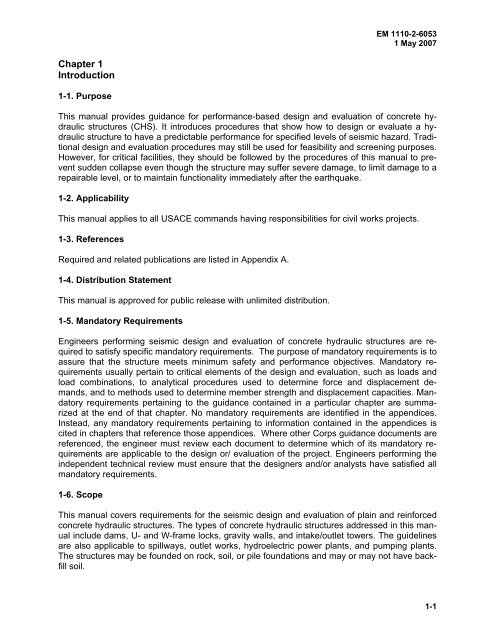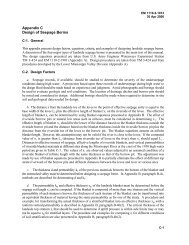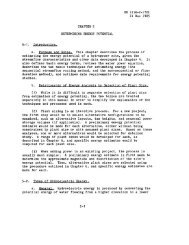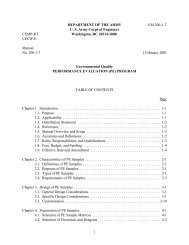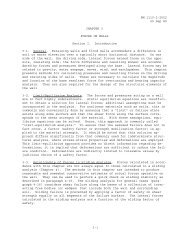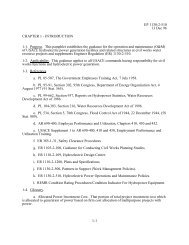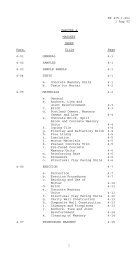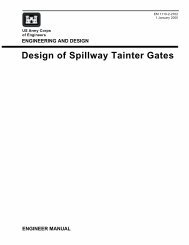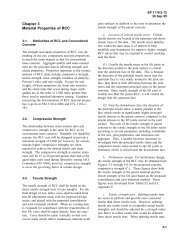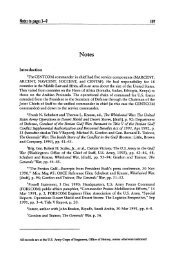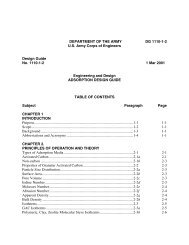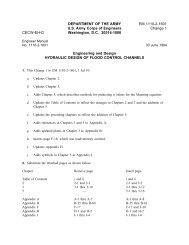Earthquake Design and Evaluation of Concrete Hydraulic Structures
Earthquake Design and Evaluation of Concrete Hydraulic Structures
Earthquake Design and Evaluation of Concrete Hydraulic Structures
You also want an ePaper? Increase the reach of your titles
YUMPU automatically turns print PDFs into web optimized ePapers that Google loves.
Chapter 1<br />
Introduction<br />
1-1. Purpose<br />
EM 1110-2-6053<br />
1 May 2007<br />
This manual provides guidance for performance-based design <strong>and</strong> evaluation <strong>of</strong> concrete hydraulic<br />
structures (CHS). It introduces procedures that show how to design or evaluate a hydraulic<br />
structure to have a predictable performance for specified levels <strong>of</strong> seismic hazard. Traditional<br />
design <strong>and</strong> evaluation procedures may still be used for feasibility <strong>and</strong> screening purposes.<br />
However, for critical facilities, they should be followed by the procedures <strong>of</strong> this manual to prevent<br />
sudden collapse even though the structure may suffer severe damage, to limit damage to a<br />
repairable level, or to maintain functionality immediately after the earthquake.<br />
1-2. Applicability<br />
This manual applies to all USACE comm<strong>and</strong>s having responsibilities for civil works projects.<br />
1-3. References<br />
Required <strong>and</strong> related publications are listed in Appendix A.<br />
1-4. Distribution Statement<br />
This manual is approved for public release with unlimited distribution.<br />
1-5. M<strong>and</strong>atory Requirements<br />
Engineers performing seismic design <strong>and</strong> evaluation <strong>of</strong> concrete hydraulic structures are required<br />
to satisfy specific m<strong>and</strong>atory requirements. The purpose <strong>of</strong> m<strong>and</strong>atory requirements is to<br />
assure that the structure meets minimum safety <strong>and</strong> performance objectives. M<strong>and</strong>atory requirements<br />
usually pertain to critical elements <strong>of</strong> the design <strong>and</strong> evaluation, such as loads <strong>and</strong><br />
load combinations, to analytical procedures used to determine force <strong>and</strong> displacement dem<strong>and</strong>s,<br />
<strong>and</strong> to methods used to determine member strength <strong>and</strong> displacement capacities. M<strong>and</strong>atory<br />
requirements pertaining to the guidance contained in a particular chapter are summarized<br />
at the end <strong>of</strong> that chapter. No m<strong>and</strong>atory requirements are identified in the appendices.<br />
Instead, any m<strong>and</strong>atory requirements pertaining to information contained in the appendices is<br />
cited in chapters that reference those appendices. Where other Corps guidance documents are<br />
referenced, the engineer must review each document to determine which <strong>of</strong> its m<strong>and</strong>atory requirements<br />
are applicable to the design or/ evaluation <strong>of</strong> the project. Engineers performing the<br />
independent technical review must ensure that the designers <strong>and</strong>/or analysts have satisfied all<br />
m<strong>and</strong>atory requirements.<br />
1-6. Scope<br />
This manual covers requirements for the seismic design <strong>and</strong> evaluation <strong>of</strong> plain <strong>and</strong> reinforced<br />
concrete hydraulic structures. The types <strong>of</strong> concrete hydraulic structures addressed in this manual<br />
include dams, U- <strong>and</strong> W-frame locks, gravity walls, <strong>and</strong> intake/outlet towers. The guidelines<br />
are also applicable to spillways, outlet works, hydroelectric power plants, <strong>and</strong> pumping plants.<br />
The structures may be founded on rock, soil, or pile foundations <strong>and</strong> may or may not have backfill<br />
soil.<br />
1-1


